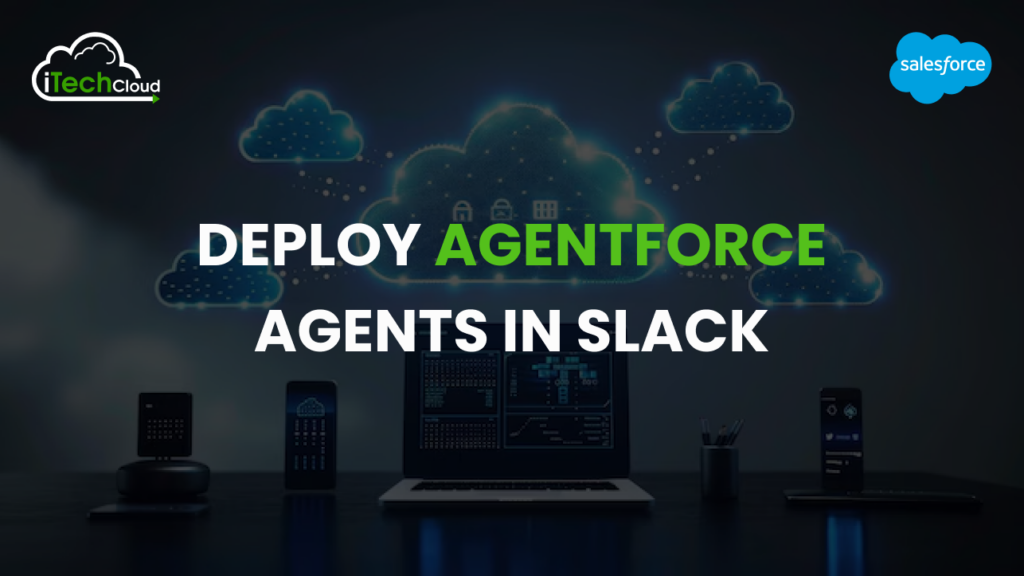Deploy Agentforce Agents in Slack

Slack has become one of the most popular collaboration platforms, enabling teams to communicate, share files, and automate workflows efficiently. With the rise of AI and automation, businesses are increasingly integrating intelligent agents into Slack to enhance productivity. Agentforce is a powerful framework that allows developers to deploy autonomous AI agents within Slack, automating tasks, answering queries, and streamlining workflows.
In this detailed guide, we’ll explore how to deploy Agentforce agents in Slack, covering setup, configuration, use cases, and best practices.
Table of Contents
Understanding Agentforce and Slack Integration
What is Agentforce?
Agentforce is a platform that enables the creation and deployment of AI-driven agents capable of performing tasks autonomously. These agents can interact with users, process data, and execute workflows, making them ideal for business automation.
Why Deploy Agentforce Agents in Slack?
1. Seamless Communication:
Agents can respond to messages, provide real-time updates, and assist teams directly within Slack.
2. Automation of Repetitive Tasks:
Agents can handle FAQs, schedule meetings, or fetch data without human intervention.
3. Enhanced Productivity:
By offloading routine tasks to AI agents, employees can focus on higher-value work.
2. Prerequisites for Deployment
Before deploying an Agentforce agent in Slack, ensure you have:
- A Slack workspace with admin permissions.
- An Agentforce account with API access.
- Basic knowledge of Slack’s API and Bot integration.
3. Step-by-Step Deployment Process
Step 1: Create a Slack App
- Go to Slack API and click “Create New App.”
- Choose “From scratch” and provide a name (e.g., “Agentforce Bot”).
- Select your workspace and click “Create App.”
Step 2: Configure Bot Permissions
1. Navigate to “OAuth & Permissions” in the sidebar.
2. Under “Scopes,” add the following Bot Token Scopes:
- app_mentions: read
- chat: write
- commands
- im:history
- im:write
Step 3: Install the Bot in Your Workspace
- Go to “Install App” and click “Install to Workspace.”
- Authorize the bot and note the Bot User OAuth Token (needed for Agentforce integration).
Step 4: Set Up Agentforce Agent
- Log in to your Agentforce dashboard.
- Create a new agent or select an existing one.
- Navigate to “Integrations” and select Slack.
- Enter the Slack Bot Token obtained earlier.
Step 5: Configure Agent Responses
- Define triggers (e.g., mentions, keywords).
- Set up automated responses or workflows (e.g., fetching data, scheduling tasks).
- Test the agent in a Slack channel by mentioning it (@AgentforceBot).
Step 6: Deploy and Monitor
- Once configured, deploy the agent.
- Monitor interactions via Agentforce logs and Slack’s activity dashboard.
Use Cases for Agentforce Agents in Slack
Agentforce Agents in Slack streamline workflows and enhance productivity through automation across various business functions. Here are five key use cases:
1. Customer Support Automation:
Agents handle FAQs, provide instant responses, and escalate complex issues to human agents, improving response times and reducing support team workload.
2. Internal IT Helpdesk:
Employees can resolve common IT queries (e.g., password resets, software troubleshooting) via automated responses, minimizing downtime and freeing up IT staff for critical tasks.
3. Meeting Scheduling:
Agents simplify scheduling by coordinating calendars, setting reminders, and booking meetings through natural language commands (e.g., “Schedule a team meeting next Monday”), saving time on back-and-forth communication.
4. Data Retrieval & Reporting:
Agents fetch real-time data from CRMs, generate reports, or provide analytics upon request (e.g., “Show Q2 sales figures”), enabling quick, data-driven decisions without manual extraction.
5. Onboarding & Training:
New hires interact with agents to access training materials, policy documents, and FAQs, ensuring a smooth onboarding process and reducing repetitive queries to HR.
Best Practices for Optimal Performance of Agentforce Agents in Slack
To maximize the efficiency and reliability of Agentforce Agents in Slack, follow these best practices:
1. Clear Trigger Phrases
Define specific commands (e.g., @bot help, fetch report) to activate the agent intentionally. This prevents unnecessary triggers and ensures precise interactions. Well-structured phrases improve user experience and reduce confusion.
2. Human Fallback Mechanism
While AI agents handle routine queries, complex or ambiguous requests should be seamlessly escalated to human agents. Implementing a smooth handoff ensures unresolved issues are addressed promptly, maintaining user trust and satisfaction.
3. Regular Updates & Training
Continuously refine the agent’s knowledge base using real user interactions and feedback. Machine learning helps adapt to new queries, improving accuracy over time. Periodic updates ensure the bot stays relevant as business needs evolve.
4. Security & Compliance
Restrict access to sensitive data and adhere to regulations like GDPR and Slack’s policies. Implement role-based permissions, encryption, and audit logs to protect confidential information while maintaining compliance.
The Future of AI Agents in Slack
AI agents in Slack are rapidly evolving, transforming how teams communicate, collaborate, and automate workflows. As artificial intelligence advances, these agents will become even more intuitive, proactive, and deeply integrated into business operations. Here’s what the future holds:
1. Hyper-Personalized Assistance
Future AI agents will leverage deeper contextual understanding to provide personalized responses based on user roles, past interactions, and real-time needs. Instead of generic replies, they will anticipate requests like suggesting relevant documents before a meeting or auto-generating reports based on historical queries.
2. Seamless Multi-Platform Integration
AI agents will extend beyond Slack, connecting with external tools (CRM, ERP, project management apps) to execute cross-platform tasks. For example, an agent could update a Salesforce record, create a Jira ticket, and notify the team in Slack all from a single natural language command.
3. Proactive Workflow Automation
AI agents will predict and initiate actions. They might flag urgent emails, recommend process optimizations, or auto-schedule follow-ups based on chat sentiment analysis. This shift from reactive to proactive assistance will redefine productivity.
4. Advanced Natural Language Understanding
Agents will handle complex, multi-step queries with near-human comprehension. Users will converse naturally (e.g., “Draft a project plan for X, including timelines and risks”) and receive polished, actionable outputs.
5. Enhanced Security and Compliance
Future agents will embed stricter access controls, real-time compliance checks, and audit trails. Privacy-preserving techniques like federated learning will ensure data security while maintaining performance.
6. Voice and Multimodal Interactions
Voice-enabled AI agents in Slack could allow hands-free updates or meeting summaries. Integration with AR/VR might enable virtual workspace assistants, blending text, voice, and visual inputs for richer collaboration.
7. Democratization of AI Development
Low-code tools will empower non-technical users to customize agents for niche use cases (e.g., legal contract reviews or inventory tracking), making AI accessible across departments.
Conclusion
Deploying Agentforce agents in Slack streamlines workflows, automates tasks, and enhances team productivity. By integrating AI-powered assistants, businesses can handle FAQs, schedule meetings, retrieve data, and improve internal support all within Slack. The setup involves creating a Slack app, configuring permissions, and linking it to Agentforce. With clear triggers, human fallback options, and continuous training, these agents deliver seamless automation.

